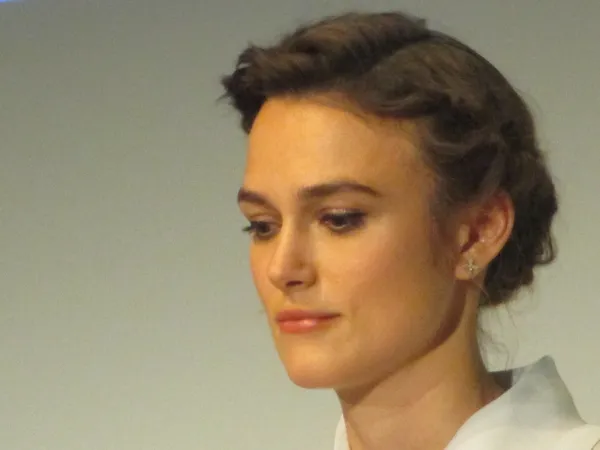Producer Julia Rosenberg has assembled a formidable team (executive producer Robert Lantos, screenwriters David Bezmozgis and Erik Rutherford, designers François Moret and Uwe Heidschötter) and cast for the animation feature film Charlotte, directed by Tahir Rana and Éric Warin, with Keira Knightley as the voice of Charlotte Salomon. Brenda Blethyn and Jim Broadbent voice Charlotte’s grandparents, Eddie Marsan her father, Helen McCrory her stepmother, Sophie Okonedo her patron Ottilie Moore, and Pippa Bennett-Warner her friend Barbara. Mark Strong is Alfred Wolfsohn and Sam Claflin Alexander Nagler. In the French version Julia has Marion Cotillard (also an executive producer) as Charlotte and Romain Duris as Alfred Wolfsohn.
 |
| Julia Rosenberg with Anne-Katrin Titze on screenwriter David Bezmozgis: “He has been nominated for the Giller Prize in Canada three times, one of the few novelists who has.” |
Charlotte tells the story of the artist Charlotte Salomon (1917-1943), whose collection of paintings, called Life? Or Theater?, can be considered one of the first graphic novels. The autobiographical artworks tell of moments of joy and first loves as well as extreme distress while living and studying in Berlin in the Thirties, and later fleeing from the Nazis to the South of France. Charlotte Salomon died on October 10, 1943, five months pregnant, the day she arrived at Auschwitz.
The animated feature is a celebration of a life cut short and with great attention to detail, inspired by Charlotte’s own paintings, tells the story of this extraordinary artist. From the death of her mother to an opera performance by her stepmother in 1933, interrupted by Nazis storming in, to meeting future benefactor Otilie Moore in Rome, to being accepted, then expelled from the Art Academy to crushes and family revelations - we see how she manifests her belief that “happiness is much deeper than suffering.” The light changes when she travels to the Côte d'Azur to take care of her grandparents, but the dangers remain and she has to make the most difficult decisions.
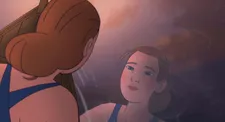 |
| Charlotte Salomon sees her reflection |
From Toronto, Julia Rosenberg joined me on Zoom for an in-depth conversation on Charlotte.
Anne-Katrin Titze: Charlotte Salomon, her life, her art, so much deserves every eye that discovers her through your film. What was your first encounter with her?
Julia Rosenberg: I was given the book Life? Or Theater?, the collection of her paintings, when I was 13 years old. So her work has been with me for a very long time. The story I tell is that, and it’s true, that every time I fell in love I would buy this book for the man in question and say: Here, this is very important to me, you must know it! So it’s almost been a totem, if you will, for me for decades now.
AKT: So you are the starting point for the entire endeavour of this film?
JR: This time yes. It’s not always the case when I produce, but this time absolutely.
AKT: You have two great actresses to voice Charlotte. I saw the one with Keira Knightley. The French version is with Marion Cotillard. How did these two come on board?
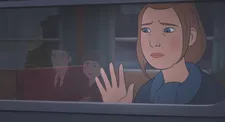 |
| Charlotte wave goodbye to her father and stepmother |
JR: Keira and the incredible cast that accompanies her, from Jim Broadbent to Sophie Okonedo; it’s one of Helen McCrory’s last performances. I worked with a tremendously fantastic casting director in London named Kate Ringsell. I think it was a combination of her relationships, my track record if you will, but it’s really the screenplay.
David Bezmozgis is a wonderful writer, is very celebrated. He has been nominated for the Giller Prize in Canada three times, one of the few novelists who has. And he wrote an astounding screenplay. It’s currently nominated for the Canadian Screen Award for Best Screenplay and The Writers Guild of Canada Award for Best Screenplay. The screenplay itself was wonderful and I think that’s why Keira came onboard. I would assume as well she wanted to support the telling of Charlotte’s tale.
AKT: So Keira was first and then Marion Cotillard joined for the French version?
JR: Yes, so the original, the VO is English and then Marion came on afterwards. Keira was recorded before animation and Marion recorded with the final film.
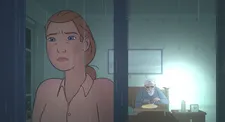 |
| Charlotte with Grosspapa at the Côte d'Azur |
AKT: There are many astonishing twists and turns about her life shown in the film. In so many films about the Holocaust you have a depiction of grandparents as one-dimensional, as the suffering pure victims. Here they are so feisty and unique and full of contradictions. Tell me a bit about how you saw Grosspapa and Grossmama!
JR: I love your description! It’s a wonderful description and of all the people I’ve talked to, you’re the first to really think about that and to juxtapose it with how grandparents are usually depicted. So it’s a very interesting question for me. The way Charlotte depicted them in her original sort of graphic novel, if you will, had that complexity to begin with. Our source material is a combination of the limited biographical detail we have of Charlotte and the way that she recounted her own life which by calling it Life? Or Theater? suggests that one has to question the veracity of what she’s representing. We took her representation of her grandparents and infused ours with that.
And she definitely makes her grandfather the protagonist. I’m sure that in your research you’ve seen that there’s a very celebrated art historian who postulates that the grandfather was particularly diabolical and awful. We worked very closely with the Charlotte Salomon Foundation and it seems a very interesting interpretation that Charlotte’s work invites us to interpret. I encourage everyone to go back to Life? Or Theater? And read it and consider what they think might or might not be true. If one tells the story of someone who perishes in the Holocaust it is still very important to do what one can to represent events truthfully because of the climate of denial.
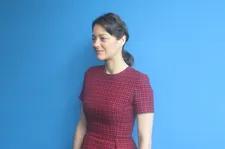 |
| Marion Cotillard is an executive producer and the French Charlotte Photo: Anne-Katrin Titze |
AKT: The way the grandfather talks to Charlotte! “It is your job to take care of us” and in the second letter he complains that she is is the one who is still here. At the same time he spills the beans about family history - I don’t want to give too much away, because it unfolds so beautifully and there is so much dimension.
I like the focus on details in your film. The necklace that looks like jade from the beginning, possibly a family heirloom, returns. Barbara who sits in the waiting room with Charlotte, in a lesser film she would simply have been the Aryan blonde girl, not here, she does return and has a larger role to play. A third detail I picked up are the strawberries. First we see little white flowers being watered and later we see the berries. It’s that attention to detail that I very much appreciate.
JR: I’m getting chills. Yes, the necklace was particularly important to us in the scripting process. This was developed as a live action film, so the screenwriter, we, worked on the script for four years before we started to put it together. We thought a lot about the ghost of the mother, the presence of her and that little necklace allowed us to conjure that.
AKT: So the necklace is your invention? It’s nowhere in Charlotte’s work?
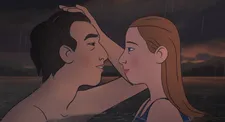 |
| Alfred Wolfsohn with Charlotte Salomon |
JR: No, it’s not.
AKT: A much more chilling theme is the lake, Lake Wannsee. Of all the possible places this is where the mother’s sister drowned. Then we see them swimming there. And of course it’s the location in January 1942 of the Wannsee Conference. It is private and world history intertwining in a very eerie way.
JR: It’s interesting, this all comes from Life? Or Theater? Those events she recounted in her memoir, her novel. The one event we made up completely was her going to the museum with Barbara. She doesn’t put that in Life? Or Theater? but we imagined that as art students - it’s still on record as the art show that has been the most attended in the 20th century - and so we thought they would have gone for sure. So we scripted that scene of her going to the Degenerate Art Show.
AKT: Now that you bring this up, there is an unfortunate typo on the wall of the art show. There’s a misspelling [Rasse = race, becomes Rasen = lawn] The translation also goes in the wrong direction when it says “the revelation of the Jewish radical soul”. It is “racial” but then that is misspelled on the wall.
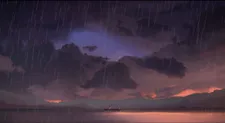 |
| Alfred and Charlotte on Lake Wannsee |
JR: Oh no! It happens, it can go in our bloopers, I guess. It’s too bad. It would have been more interesting. I think our character designer, Uwe Heidschötter is German and I think we showed it to him, but it slipped through the cracks.
AKT: For the ending I think you made a very good choice. Did you have different endings? Was that always the one in the script?
JR: That was always there. The idea of the film came into my head when I was on my morning run ten years ago. What came into my head was Charlotte drew her life story so I needed to produce an animated film of her life story, never having worked in animation before. Even before I had approached screenwriters that ending was in my head. It’s been there as an unquestioned impulse
AKT: It’s perfect. I was very glad you ended the film this way.
JR: What did it evoke for you?
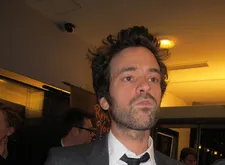 |
| Romain Duris is the French Alfred Wolfsohn Photo: Anne-Katrin Titze |
AKT: On the one hand, there are the palm trees swaying, nature is remaining, almost standing still. Humans come and go and this remains. A certain kind of calm. I was glad that we don’t see what is happening next. I was also wondering about the Gestapo officer if he was somehow modelled after Klaus Barbie a little bit?
JR: No, it’s modelled after the man who rounded them up, who took them.
AKT: I think we all in our heads construct the rest. It’s much better than showing anything further.
JR: For me the first impulse was wanting to create a moment at the end of the film where we feel Charlotte’s been taken from it. We feel her absence. So we’re there and she’s gone. And just to sit with that feeling.
AKT: Did you ever see Claude Lanzmann’s Four Sisters?
JR: No.
AKT: It’s about four women, four separate interviews with survivors that didn’t fit into Shoah.
JR: Oh, I’m going to write it down! Thank you!
AKT: Absolutely devastating. I was thinking in particular of one of them [Ruth Elias in The Hippocratic Oath] who gave birth in the camp and was one of Mengele’s “subjects.” The fact that you state at the end of your film that Charlotte died the first day she arrived at Auschwitz, it was almost, as terrible as it is, a kind of relief. I don’t know…
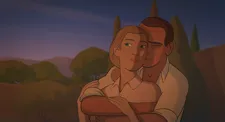 |
| Charlotte Salomon with her fiancé Alexander Nagler |
JR: No, for sure. I think that’s true. If I remember correctly the Hungarian filmmaker János Szász, I think his name is, he was born in Auschwitz, or his parents met in Auschwitz. I think when women were impregnated at Auschwitz that was one thing, but as all the Jews were selected upon arrival, of course they thought a pregnant woman was more a problem than a benefit. That’s why she was killed on the day of arrival.
AKT: And maybe Mengele wasn’t there, because the woman in the Four Sisters arrived pregnant as well.
JR: Oh she did? Okay.
AKT: On a [another] lighter note, I like how the light changes in the animation, from the first part in Berlin. We don’t even notice the darkness, the greyness that much until the South of France shows itself. As far as the animation is concerned that is beautifully done.
JR: I’m glad, as Canadians we know that feeling very well. Yes, and I think the choice of having her on the train really allows that to come forward.
AKT: I never had the thought in an animated film before, but I caught myself wondering for a second, who is the costume designer? I liked so much what Charlotte is wearing.
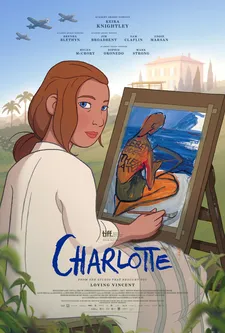 |
| Charlotte poster |
JR: That’s very funny! I’m trying to think of who did it, if it was François [Moret, the production designer] or Uwe. I don’t know. I think it was Uwe, the character designer.
AKT: It’s wonderful that it feels so alive that you can wonder who dressed her.
JR: Oh yeah, it’s true. Did you forget that it was animated? Some people say that.
AKT: For a second, yes, but definitely not throughout because the film is also so much about how her own artworks come to life. There’s a constant reminder. But then you see her and think, I like that combination of the pale blue blouse with the beige cardigan. Come to think of it, I’m wearing something similar today, by chance.
JR: That’s true! On the topic of is it or isn’t it animated, how did you find the news footage in the epilogue?
AKT: Strong, very powerful! It makes us go back and see parts of the film again in our heads.
JR: The comments I received on that is that one sort of forgets that it’s animation but at the same time it’s still a cartoon on some level. And then when we see the parents and are reminded that no, this is a true story and all of this actually happened.
AKT: I didn’t forget that it actually happened. How did Robert Lantos get involved?
JR: Robert’s an executive producer. I started my career with Robert. At one point I asked him if he would help me with some things and he did, so he became the Executive Producer.
AKT: I did an event at the Museum of Tolerance with him and Atom Egoyan for Remember and also talked to him for The Song of Names. That’s why I noticed his name in the end credits.
 |
| Charlotte opens at the Quad Cinema in New York on April 22 Photo: Anne-Katrin Titze |
JR: We did [Jeremy Podeswa’s] Fugitive Pieces together, which touched on the Holocaust. We did Sunshine [directed by István Szabó] together, we did the Michael Caine, The Statement [directed by Norman Jewison] together. I also worked on films that were set in the Shoah. We’re doing an event at The Museum of Tolerance in L.A. on the 12th and we’re doing a screening at the JCC on the 19th in New York.
AKT: Thank you for bringing Charlotte’s story to the screen!
JR: Thank you, I’m glad it moved you. The goal of all of us is to bring Charlotte’s story to the world. If that’s affected you then we’ve done our job!
On Tuesday, April 19 there will be a special screening of Charlotte at the Marlene Myerson JCC in Manhattan at 7:00pm, followed by a Q&A with Julia Rosenberg, Tahir Rana, and Éric Warin.
Charlotte opens at the Quad Cinema in New York on April 22.








